According to the Chicago Fed National Activity Index, April economic activity increased from March. This is the first increase after three consecutive declines. Here are the opening paragraphs from the report:
Led by improvements in production-related indicators, the Chicago Fed National Activity Index (CFNAI) rose to +0.11 in April from –0.44 in March. Of the four broad categories of indicators that make up the index, only the production and income category and sales, orders, and inventories category improved from March and made a positive contribution in April.
The index’s three-month moving average, CFNAI-MA3, ticked down to –0.06 in April from +0.02 in March, falling below zero for the first time since November 2011. April’s CFNAI-MA3 suggests that growth in national economic activity was near its historical trend. The economic growth reflected in this level of the CFNAI-MA3 suggests subdued inflationary pressure from economic activity over the coming year.
The CFNAI Diffusion Index also moved lower in April, declining to +0.10 from +0.19 in the previous month. Forty-five of the 85 individual indicators made positive contributions to the CFNAI in April, while 40 made negative contributions. Forty-six indicators improved from March to April, while 37 indicators deteriorated and two were unchanged. Of the indicators that improved, thirteen made negative contributions. [Download PDF News Release]
The Chicago Fed's National Activity Index (CFNAI) is a monthly indicator designed to gauge overall economic activity and related inflationary pressure. It is a composite of 85 monthly indicators as explained in this background PDF file on the Chicago Fed's website. The index is constructed so that the historical index average is zero. Postive monthly values indicate above-average growth, negative values indicate below-average growth.
The first chart below is based on the complete CFNAI historical series dating from March 1967. The red dots show the indicator itself, which is quite noisy, and the 3-month moving average (CFNAI-MA3), which is more useful as an indicator of coincident economic activity. I've also highlighted official recessions.
For a clearer look at the recent behavior of the index, here is a closeup view since 2007. 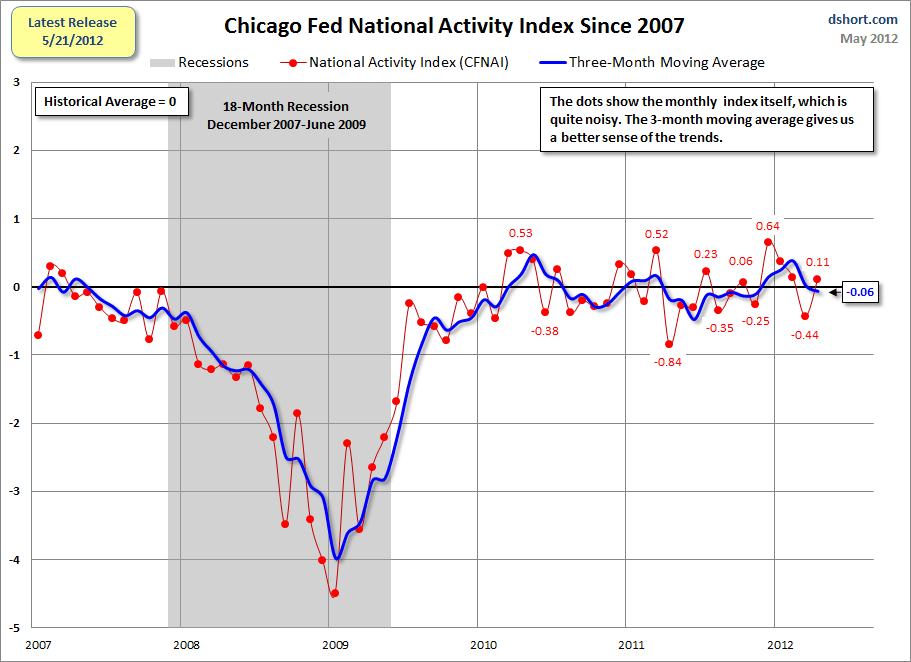
The next chart highlights the -0.7 level. The Chicago Fed explains:
When the CFNAI-MA3 value moves below -0.70 following a period of economic expansion, there is an increasing likelihood that a recession has begun. Conversely, when the CFNAI-MA3 value moves above -0.70 following a period of economic contraction, there is an increasing likelihood that a recession has ended.
With the exception of the 1973-75 recession, the -0.7 level has coincided fairly closely with recession boundaries. The 1973-75 event was perhaps an outlier because of the rapid rise of inflation following the 1973 Oil Embargo. Otherwise a cross below the -0.7 level has synchronized within a month or two of a recession start. A cross above the level has lagged recession ends by 2-4 months. 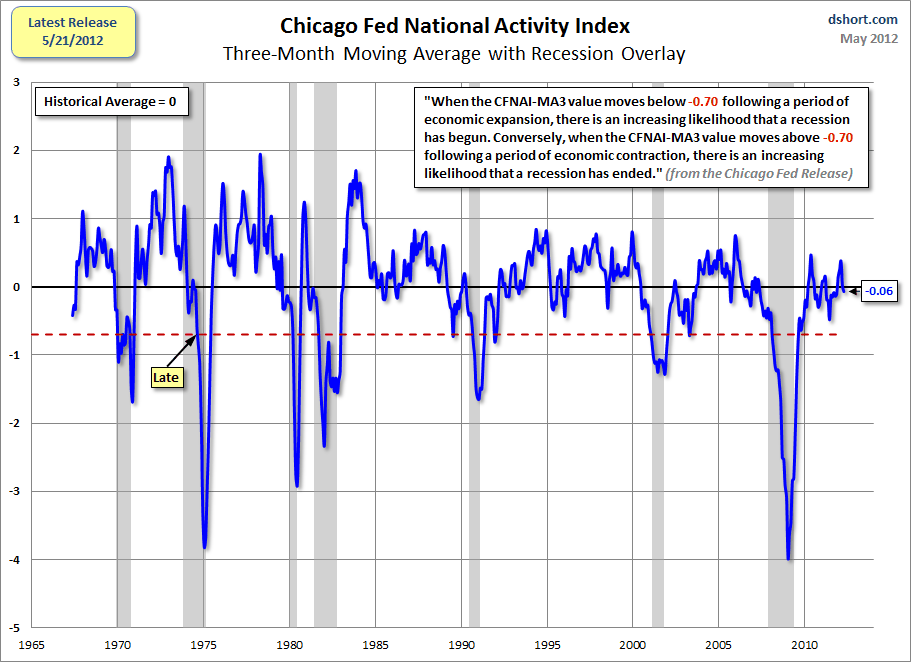
The next chart includes an overlay of GDP, which reinforces the accuracy of the CFNAI as an indicator of coincident economic activity. 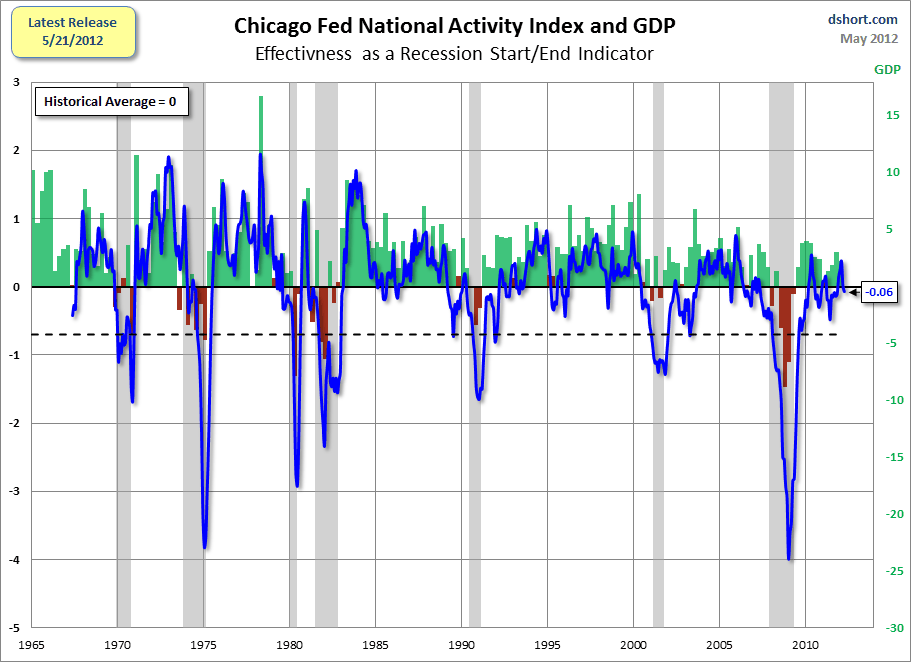
Here's a chart of the CFNAI without the MA3 overlay — for the purpose of highlighting the high inter-month volatility. Consider: the index has ranged from a high 2.57 to a low of -4.78 with a average monthly change of 0.60. That's 8% of the entire index range! 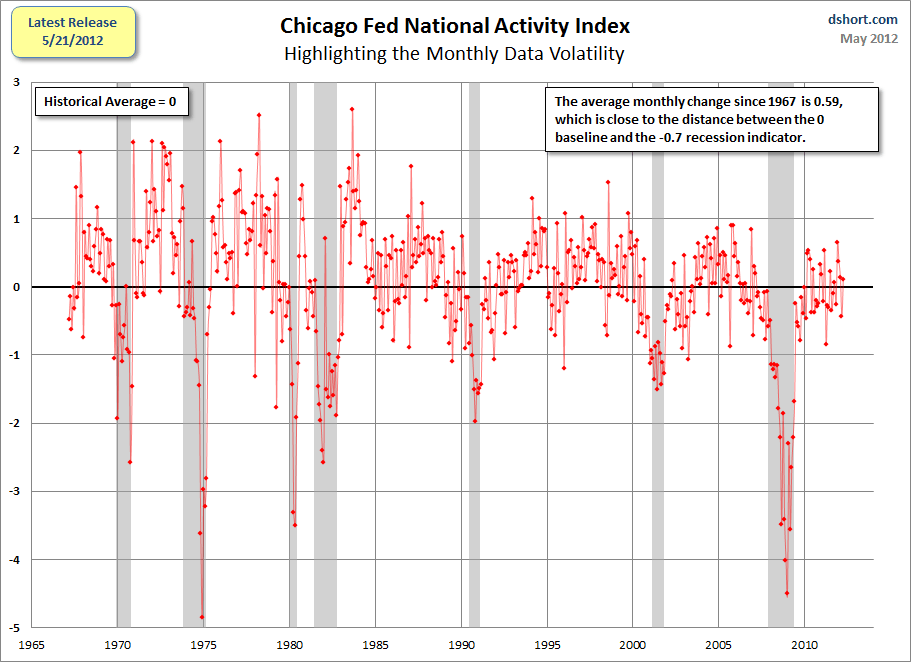
Further underscoring the volatility is the roller-coaster list of CFNAI monthly headlines from 2010 forward. 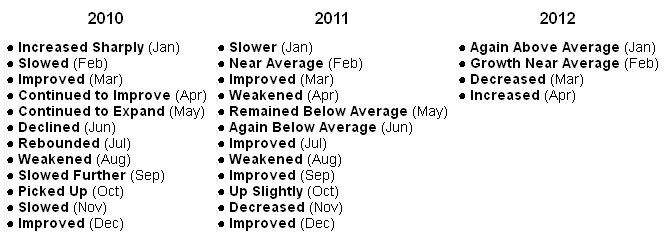
As monthly chart depicts and the headline verbs reinforce, it's unwise to read very much in the data for any specific month. The 3-month moving average is the number to watch.
The Long-Term Economic Trend
In the final chart I've let Excel draw a linear regression through the CFNAI data series. The slope confirms the casual impression of the previous charts that National Activity, as a function of the 85 indicators in the index, has been declining since its inception in the late 1960s, a trend that roughly coincides with the transition from a good-producing to a post-industrial service economy in the information age. 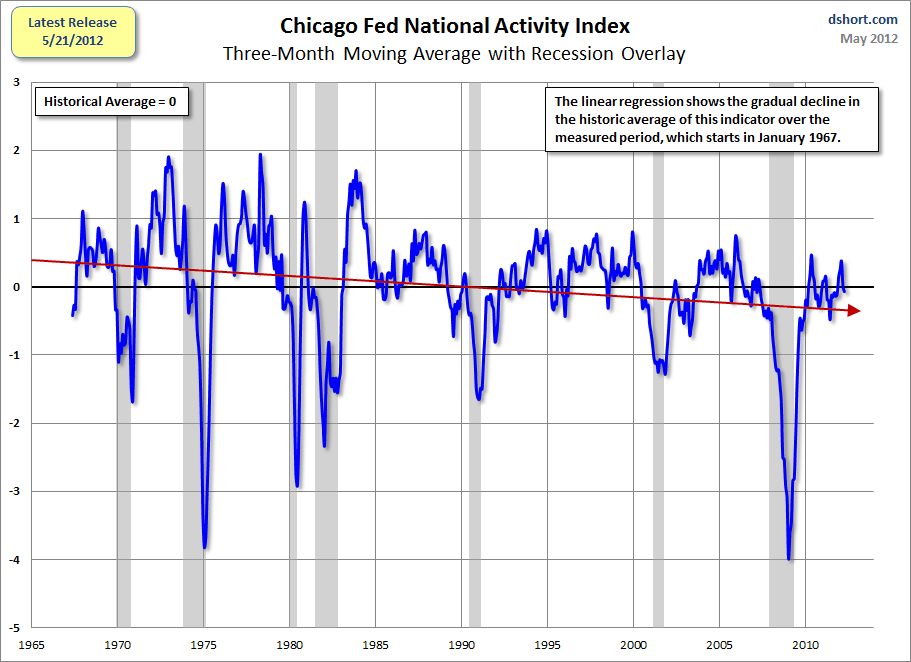
- English (UK)
- English (India)
- English (Canada)
- English (Australia)
- English (South Africa)
- English (Philippines)
- English (Nigeria)
- Deutsch
- Español (España)
- Español (México)
- Français
- Italiano
- Nederlands
- Português (Portugal)
- Polski
- Português (Brasil)
- Русский
- Türkçe
- العربية
- Ελληνικά
- Svenska
- Suomi
- עברית
- 日本語
- 한국어
- 简体中文
- 繁體中文
- Bahasa Indonesia
- Bahasa Melayu
- ไทย
- Tiếng Việt
- हिंदी
Chicago Fed: Economic Activity Increased In April
Published 05/22/2012, 01:47 AM
Updated 07/09/2023, 06:31 AM
Chicago Fed: Economic Activity Increased In April
Latest comments
Loading next article…
Install Our App
Risk Disclosure: Trading in financial instruments and/or cryptocurrencies involves high risks including the risk of losing some, or all, of your investment amount, and may not be suitable for all investors. Prices of cryptocurrencies are extremely volatile and may be affected by external factors such as financial, regulatory or political events. Trading on margin increases the financial risks.
Before deciding to trade in financial instrument or cryptocurrencies you should be fully informed of the risks and costs associated with trading the financial markets, carefully consider your investment objectives, level of experience, and risk appetite, and seek professional advice where needed.
Fusion Media would like to remind you that the data contained in this website is not necessarily real-time nor accurate. The data and prices on the website are not necessarily provided by any market or exchange, but may be provided by market makers, and so prices may not be accurate and may differ from the actual price at any given market, meaning prices are indicative and not appropriate for trading purposes. Fusion Media and any provider of the data contained in this website will not accept liability for any loss or damage as a result of your trading, or your reliance on the information contained within this website.
It is prohibited to use, store, reproduce, display, modify, transmit or distribute the data contained in this website without the explicit prior written permission of Fusion Media and/or the data provider. All intellectual property rights are reserved by the providers and/or the exchange providing the data contained in this website.
Fusion Media may be compensated by the advertisers that appear on the website, based on your interaction with the advertisements or advertisers.
Before deciding to trade in financial instrument or cryptocurrencies you should be fully informed of the risks and costs associated with trading the financial markets, carefully consider your investment objectives, level of experience, and risk appetite, and seek professional advice where needed.
Fusion Media would like to remind you that the data contained in this website is not necessarily real-time nor accurate. The data and prices on the website are not necessarily provided by any market or exchange, but may be provided by market makers, and so prices may not be accurate and may differ from the actual price at any given market, meaning prices are indicative and not appropriate for trading purposes. Fusion Media and any provider of the data contained in this website will not accept liability for any loss or damage as a result of your trading, or your reliance on the information contained within this website.
It is prohibited to use, store, reproduce, display, modify, transmit or distribute the data contained in this website without the explicit prior written permission of Fusion Media and/or the data provider. All intellectual property rights are reserved by the providers and/or the exchange providing the data contained in this website.
Fusion Media may be compensated by the advertisers that appear on the website, based on your interaction with the advertisements or advertisers.
© 2007-2024 - Fusion Media Limited. All Rights Reserved.
